Text
Following the Red Thread: Today and Tomorrow
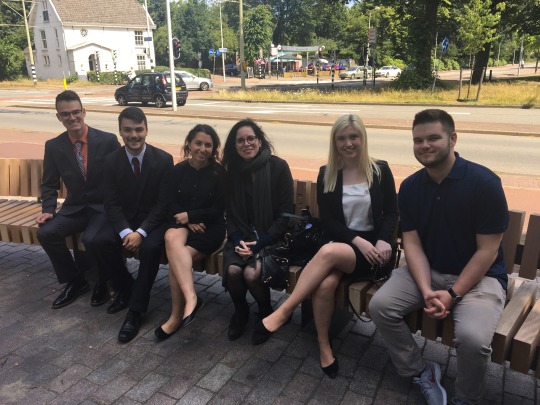
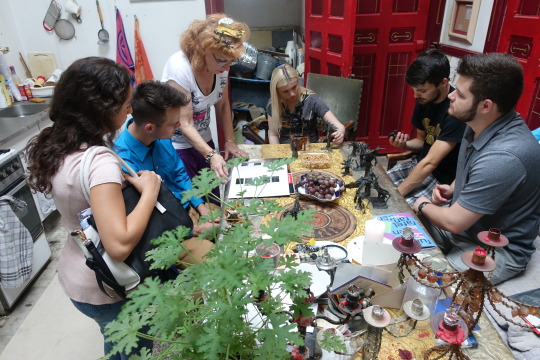
One of the most important insights which this class has provided to me is the importance of individuals and the communities which they build. In the course of history, change occurs because of dedicated and passionate individuals and their communities of like-minded individuals. The sharing of ideas between themselves and the challenge they provide to do better creates new ideas and concepts be it in philosophy, art, or the growth of law. It is the actions and interactions between these group of dedicated individuals which spins the red thread of history. Human rights and International law is a movement which yields to this principle without exception.
Two perfect examples of this red thread being carried aloft by the interactions between individuals is Henry Dunant and Bertha von Suttner. Dunant, who would go on to found the Red Cross (1), and Suttner, who would go on to win the Nobel Peace Prize (2), wrote many series of letters and correspondence between each other (3). They discussed each other’s opinions and philosophy regarding the rights of man and the law involving war. This discussion helped refine their ideals for themselves and helps others, such as ourselves, better understand the philosophies of international law- both idealism and realism. Going further, the interactions between these two individuals was fueled by the work of others and continues to fuel others to this day. Dunant was inspired, in many ways, by the work of Florence Nightingale (4), another passionate and dedicated individual who, through sheer will transformed how health care and hospitals operate (5).
Looking forward Bertha still inspires people to this day through her work towards a more peaceful world. In 2013 Ingrid Rollema, an artist and peace activist (6), created a bust of Suttner to be displayed in the Peace Palace Library (7). It was one of only two women to be hosted on the grounds of the peace place (8). Because of Bertha’s incredible work, an artist and activist in the 21st century studied her life and accomplishments, thus shaping her own understandings. During this trip my fellow classmates and myself had the opportunity to visit Rollema’s studio and discuss her work. Between herself and the team she works with, they create works on peace and violence which reach thousands around the world. In Rollema’s passion and her community we can see the red thread of history continue to spin.
An instance of pure passion which we had the opportunity to observe while here in the Netherlands was the fruition of Don Ferencz’s work to build the “Law. Not War.” Bench outside the grounds of the Peace Palace. Don, the son of Ben Ferencz, is an impassioned continually working to educate people on the work of his father, one of the last American prosecutors from the trials at Nuremberg after WWII (9). The bench started as an idea and grew into reality as Don persisted through red tape and unexpected challenges to finally create the bench (10). It’s a spot in the world for people to take a moment and rest, to ask questions, and be engaged with the peace through law movement.
For me, this class here in the Netherlands has been my opportunity to engage with the broader community and history of those working for peace in the world. Sharing in the passion and dedication of others has been an energizing experience and has better illustrated to me how the effort of individuals contributes to the development of the future. Our actions come to fruition when we work together and forge those bonds and communities. In the movie “Watchers of the sky” a reference is made to Tycho Brahe and his work in astronomy. He made the work easier so the next generation could achieve more and that is the same work which we ourselves must perform.
1. "Henri Dunant- Biographical." Accessed July 20, 2018. https://www.nobelprize.org/nobel_prizes/peace/laureates/1901/dunant-bio.html.
2. "Bertha Von Suttner- Biographical." Accessed July 20, 2018. https://www.nobelprize.org/nobel_prizes/peace/laureates/1905/suttner-bio.html.
3. "Photocopies - Letters from Bertha Von Suttner to Henri Dunant, 1895-1902 (File)." United Nations Archive Geneva. Accessed July 20, 2018. https://biblio-archive.unog.ch/detail.aspx?ID=33622.
4. "Henri Dunant." Spartacus Educational. Accessed July 20, 2018. http://spartacus-educational.com/EUdunant.htm.
5. "Florence Nightingale." Biography. Accessed July 20, 2018. https://www.biography.com/people/florence-nightingale-9423539.
6. "Ingrid Rollema." Ingrid Rollema. Accessed July 20, 2018. http://www.ingridrollema.nl/ingrid/home.htm.
7. Alihusain, C. "Ingrid Rollema and the Creation of a Bertha Von Suttner Bust with the Help of an ICJ Judge." Peace Palace Library. October 3, 2013. Accessed July 20, 2018. https://www.peacepalacelibrary.nl/2013/10/ingrid-rollema-and-the-creation-of-a-bertha-von-suttner-bust-with-the-help-of-an-icj-judge/.
8. Alihusain, C. "Dr. Aletta Jacobs: Working for World Peace." Peace Palace Library. April 24, 2015. Accessed July 20, 2018. https://www.peacepalacelibrary.nl/2015/04/dr-aletta-jacobs-working-for-world-peace/.
9. Benferencz.org. Accessed July 20, 2018. http://www.benferencz.org/tablet/index.html.
10. Benferencz.org. Accessed July 20, 2018. http://www.benferencz.org/tablet/index.html.
2 notes
·
View notes
Text
Involvement at the ICC

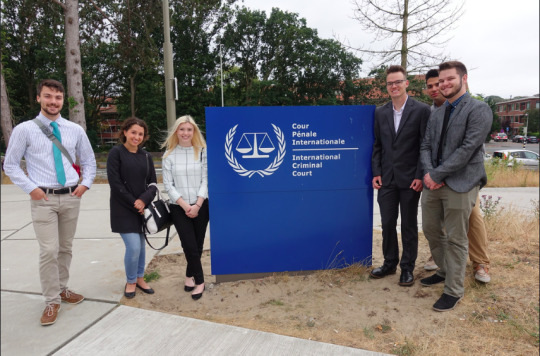
The most insightful and impactful moment for me was actually being able to go into the courtroom at the ICC. Every topic we had talked about in class both before the trip while in Mt. Pleasant and here in The Hague was so abstract before, but being able to visit the ICC was the connecting piece that put everything together for me. One thing that I have learned from working in a courtroom myself is that majority of what happens is more procedural and individual to that particular institution, so being able to learn about the specific ways the ICC functions makes it easier to understand its operations. For example, the setup of the courtroom is different than any courtroom I have previously ever seen. Something I would have never known prior to seeing the courtroom itself is that the witness stand is positioned directly across from the judges, instead of next to the judges like most American courtrooms. This may seem like a simple difference in the design of the room, but it makes a huge impact in the gravity that a witness carries by testifying in a case.
Another thing that was impactful while being in the courtroom at the ICC was learning about what the process is that victims go through while testifying. Something that would have never occurred to me before visiting the ICC and having explained to me is how foreign everything in the courtroom is to someone who is coming to a country that barely has access to the necessities. I believe being able to testify in a courtroom that is so foreign to you, in a different country, with the person who caused them all of the harm just a few feet away is quite possibly the most brave thing anyone can do and my respect for these individuals has grown tremendously. So much of what we have learned so far has been about concepts, facts, or history, but realizing what actual people have to go through to testify in court was very impactful for me. I thought it was important to learn about the process the ICC has to go through to prepare someone to testify in court, and the different outlets that may need to be taken if they are unable to actually do so in the courtroom. This was something I was completely unaware of, because it can become so easy to get stuck on legal concepts, but now the bravery and impact that victims have to testify at the ICC will resonate with me forever.
Something else we learned about while being at the ICC that involves both the composition of the courtroom and the representation of victims is the Trust Fund for Victims. The Trust Fund for Victims provides both reparations for victims as well as to support victims and their families. Prior to being at the ICC I was not aware of what the Trust Fund for Victims was at all. Since learning about what TFV is and what it does for victims I completely understand the necessity of it and the impact that it has on improving the lives of victims. I also thought that it was interesting how the TFV has a place dedicated to them in the courtroom. I believe it should definitely be required for the presence of TFV to be within the courtroom because victims deserve as much representation as they can get. That is another thing about the setup of the courtroom in which I was previously unaware of before; that the TFV has a designated spot to always be present during trials and act as an advocate for victims.
Being at the ICC during this time in general was very exciting for everyone due to both the ICC turning 20 and the jurisdiction over the crime of aggression being activated. This was an occurrence I was moved to be apart of because the energy at the ICC was so exciting. Although we were not physically present at the celebrations on July 17th, I was still able to watch part of Prosecutor Fatou Bensouda’s remarks, which were incredibly powerful and inspiring. I was able to see how the international community was coming together to celebrate these important milestones, and at least to me the lack of a presence of the United States was especially heavy on this day. It is unbelievable to me that 100 years ago the United States was such a huge champion of peace, and now we aren’t even a party to the Rome Statute. To me it is so significant that not only is the US not a signatory to the Rome Statute, but it has existed for 20 years. 20 years has gone by, and the United States has refused to back this incredibly important institution, which is just unacceptable. With the Rome Statute turning 20 that means it is older than me, so I have never lived in a world without the Rome Statute, but yet I did not learn about it until just this year and so many other people in my country have never and potentially will never learn about it due to the lack of recognition from the United States, which I am passionate about changing in my lifetime.
1. "Witnesses." International Criminal Court. Accessed July 20, 2018. https://www.icc-cpi.int/about/witnesses.
2. "Our Work." The Trust Fund for Victims. Accessed July 20, 2018. https://www.trustfundforvictims.org/en/what-we-do/projects.
3. "The ICC Rome Statute Is 20." International Criminal Court. Accessed July 20, 2018. https://www.icc-cpi.int/romestatute20.
0 notes
Text
Insight into the Labor of Peace

Over the past month, my understanding of the International Criminal Court and global community has developed, especially by learning from professionals working within the ICC. My ignorance and incorrect assumptions about the role and functions of the ICC left me open to a flood of information on the court, along with a look into the individuals employed at each level. When imagining the Court in anticipation, I pictured justices in flowing black robes, pristine court rooms, and a small lot of spectators watching in silence. These ideas, to my interest, do reflect what occurs on the day of trial. What I failed to understand was how many people are working everyday to allow the ICC to function. Although the ICC building is full of legal professionals, I realized how little I acknowledged a vast array of professionals working around the world on behalf of international criminal legal institutions.
According to the ICC website, the Court employs over 900 staff members from approximately 100 States (1). While English and French are the two working languages, the court also includes Arabic, Chinese, Russian, and Spanish as official languages (1). From the perspective of the international community, The Hague is the epicenter for international criminal justice. This experience, especially my time spent in the ICC building allowed me to realize how The Hague’s role is much greater than I ever knew in the US. Even outside of The Hague, the ICC operates six field offices in the following nations: DRC, Uganda, CAR, Kenya, and Côte d'Ivoire (1). The cooperation between these advocates for international justice over many years is what ultimately produces positive results.
This cooperation of the thoughtful, concerned individuals in the ICC building alongside people gathering evidence and taking testimony from victims leads to a court that can change the world. The court’s first verdict in 2012, against Thomas Lubanga of the DRC, proved the Court’s ability to reach men of power. Lubanga was convicted of war crimes relating to conscripting children for his militia and was sentenced to 14 years of imprisonment. (2) The highest profile person to be charged by the ICC to date is the Ivory Coast’s former President Laurent Gbagbo. Gbagbo’s 2011 conviction included murder, rape, and persecution (2). While spending time touring the ICC building, I reflected on how the actions of many individuals reach the top, forcing an end to impunity.
The international cooperation required for global justice does not end in the ICC, The Hague, or even within the ranks of employees and advocates. As explained during the Asia-Pacific Forum near the anniversary of the Rome Statute, students of justice and ethics advocate for these ideals domestically. In the United States, the American Bar Association showed an increase from 2014 in awareness of the ICC, caused by millennials. Today, awareness of the ICC is “highest among millennials (age 18-34), where 60% have heard at least a little bit about it” (3). If this upward trend in public opinion exists among other nations, the ideals of peace and justice may also rise. By spending time around the professionals working in the ICC, my insight leads to a more realistic outlook. Progress in peace is built upon the labor of countless individuals--of today and of the past. By recognizing the work it takes to make a change, I am more prepared to face international law with a realistic approach. This insight will be valuable in internship, advocacy, and education and serve as a reminder of the labor of peace.
(1) "International Criminal Court: About." Cour Penale Internationale. Accessed July 19, 2018. https://www.icc-cpi.int/about.
(2) "What Does the International Criminal Court Do?" BBC News. June 25, 2015. Accessed July 19, 2018. https://www.bbc.com/news/world-11809908.
(3) ABA-ICC Project Staff. "July 2017 Ipsos Poll Results." International Criminal Justice Today. July 17, 2017. Accessed July 19, 2018. https://www.international-criminal-justice-today.org/polling-data/2017/07/17/july-2017-ipsos-polling-results/.
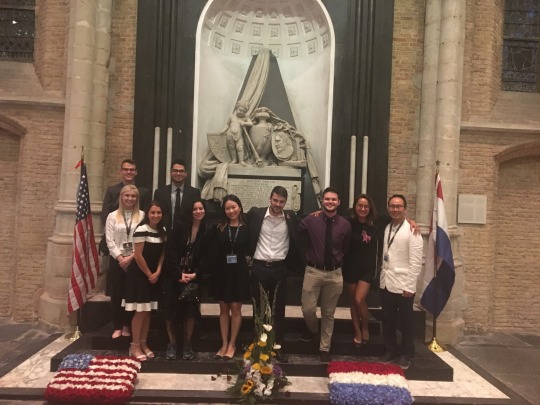
0 notes
Text
My insight on the ICJ
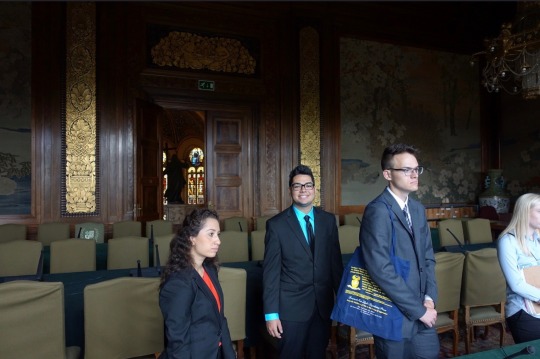
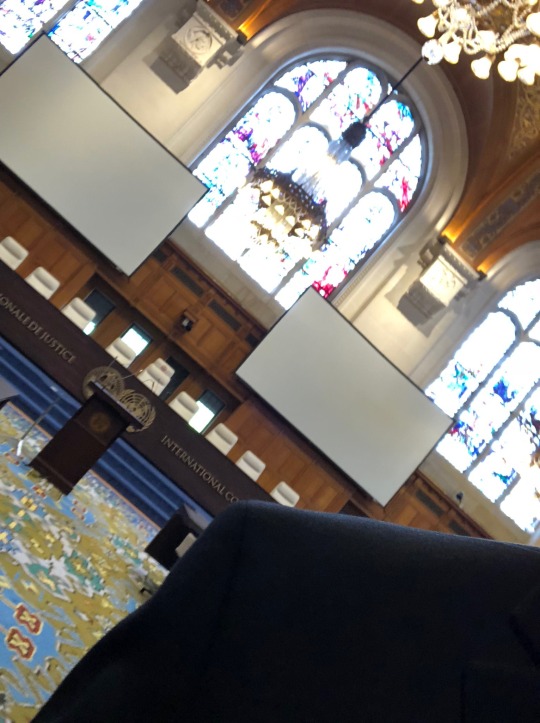
The International Court of Justice (ICJ) is an important body of the world to maintain peace and justice throughout the world. Prior to this trip to The Hague, I did not even know that the ICJ existed. This trip has opened my eyes to international law in a general sense, let alone the specifics about everything that we have learned thus far. Taking a tour of the Peace Palace and being able to see the courtroom in a quiet setting was a really cool experience that not many other people can say that they have had. Being in the courtroom during oral arguments was an experience that I will never forget, and the fact that it was two middle eastern states makes it all the more interesting to me.
The most impactful situation I have been in was sitting in on oral arguments for Qatar vs. United Arab Emirates (UAE). Although we missed out on Qatar’s opening statements, we got to sit in on UAE’s defense, and that was really cool to see. Personally, if I had to pick which side I wanted to hear, I would have chosen UAE because Qatar’s allegations of human rights violations are pretty straightforward. I really enjoyed hearing the UAE’s counterarguments to those statements and their convincing argument against Qatar’s claims (1). My next paragraph will discuss how Qatar got the UAE to court.
States have to agree to allow the ICJ to hear a case, and with the middle east not being the most peaceful place on earth, it was really shocking to me that two middle eastern entities were battling out their disagreements in court rather than on the battlefield. Another thing I found fascinating is that while states may be parties to the UN, they have to consent to the jurisdiction of the ICJ to be brought to court (2). In this case, Qatar wanted to bring suits against Egypt, UAE, Bahrain, and Saudi Arabia, but only the UAE consented to the ICJ’s jurisdiction, therefore they are the only ones being sued (3). I feel like in a way this is a flawed system. If a state is going to be a UN party member, then ICJ jurisdiction should automatically apply to them.
This topic is important to me because my family comes from the middle east. Living in the United States, the middle east is hardly ever reported on, so it makes keeping up with events going on difficult. Furthermore, to be able to physically go inside of the Peace Palace, never mind sit in on an ICJ case, let alone that case be about human rights violations in the middle east was just mind blowingly cool to me. If it were not for this trip, I would not even know what the ICJ was or how it operated. Not many people are able to say that they have sat in on an ICJ hearing, and I am thankful and blessed to be able to say that I have.
(1): https://www.presstv.com/DetailFr/2018/06/11/564687/Qatar-UAE-human-rights-violations-International-Court
(2): http://www.icj-cij.org/en/jurisdiction
(3): https://www.ft.com/content/310d6636-6d8c-11e8-852d-d8b934ff5ffa
1 note
·
View note
Text
Insight into the ICC
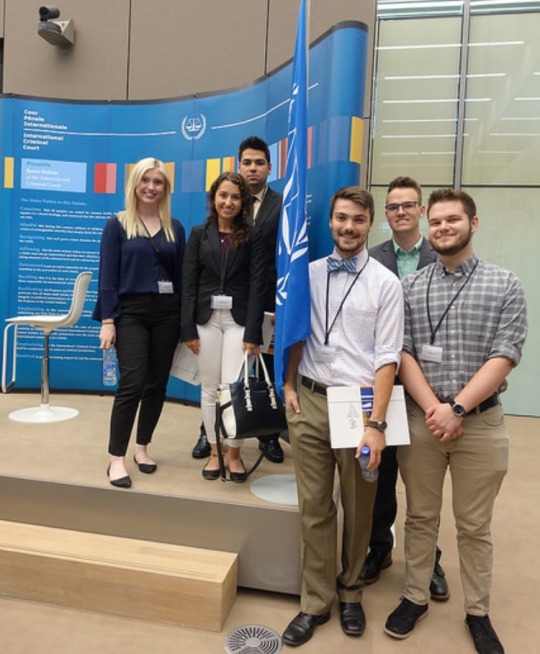
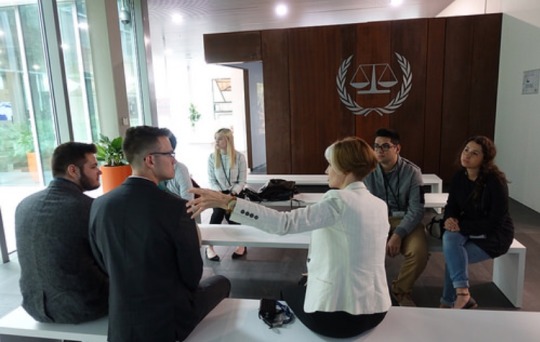
I, like most people, have always had such an uncomfortable feeling in my mind about the many horrors of war. Just knowing war goes on in other countries is bad enough, let alone hearing about specific incidents on the news makes it so much more realistically horrifying. One example of this was when I had heard about Kony on the news and how he has kidnapped hundreds to possibly thousands of children and brainwashed them to do whatever he tells them to do in his Lord’s Resistance Army. (1) This description of what Kony has done is vague, to say the least. However, vague nonetheless, it is still scary enough to hear without going into detail which shows how inhumane what he has done is. These atrocities he has committed are terrifying to me, especially as a teenager hearing about Kony, and I would feel a huge relief knowing he is being prosecuted for them. Just knowing the International Criminal Court (ICC) exists to prosecute several crimes related to war, such as what Kony has done, gives me relief.
However, the real relief came to me after and during the tour of the ICC. It all became so clear what the procedure is and how thorough it is. What is especially insightful to me is how involved the victim is in the trial process and that they are present at trial. Also, the fact that the victim gets reparations beyond just the criminal being placed behind bars is astounding. In the instance of Kony and the Lord’s Resistance Army, it is clear how thorough the procedure to try individuals is and sadly these suspects are still at large, but the ICC has the case ready to start as they exclaim they are in the pre-trial stage till the suspects are arrested and present at the ICC in The Hague. (2) This is just one example of how real it is that the ICC is able to prosecute horrifying individuals for their actions. It is also important to keep in mind that there are cases that have gone through the entire procedure and many suspects have ended up behind bars, it just so happens that as of now the Kony case is not one of them.
Beyond this, I was told during the tour specific numbers of just how many people have been prosecuted. I have learned about how many states are a member to the ICC. I have discovered how much care the victim gets before, during, and after the trial. Also, the witness alone gets a vast amount of care emotionally and physically. The witness, in particular, receives care through the witness protection program of the ICC. In this program there are several levels of assisting the witness to ensure their safety, this includes: protective measures, security arrangements, counseling, physical and psychological well-being, protection, humanitarian and criminal law, psychology, gender and cultural diversity, and dealing with children whether they have experienced trauma or not. (3) It is clear that this program the ICC has for witnesses is very thorough and they truly do all they can to protect their witnesses since the witness does so much for them by testifying at trial.
To me, all of this information clarifies that something in this world is being done to get rid of these horrifying war actions and the world is not just sitting back and letting them happen. This is extremely important to me because all of this inside information about the ICC and its purpose justifies my hatred towards war related crimes. The ICC, as of July 17, 2018, has jurisdiction over: genocide, war crimes, crimes against humanity, and crimes of aggression. (2) These areas of subject matter jurisdiction cover many crimes and I personally find relief in this. As for the future, I hope that one day the vast majority of states are a member state to the ICC and have ratified the Rome Statute. If this can be done then the mission of deterring individuals from committing these atrocities has higher chances of being fulfilled.
(1) Smith, David. "Joseph Kony Kidnapped 591 Children in past Three Years, UN Report Reveals." The Guardian. June 07, 2012. Accessed July 19, 2018. https://www.theguardian.com/world/2012/jun/07/joseph-kony-united-nations-report.
(2) "Kony Et Al. Case." International Criminal Court. Accessed July 19, 2018. https://www.icc-cpi.int/uganda/kony.
(3) "Is Enough Being Done to Protect ICC Witnesses?" Coalition for the International Criminal Court | Global Justice for Atrocities. May 18, 2015. Accessed July 19, 2018. http://www.coalitionfortheicc.org/news/20150518/enough-being-done-protect-icc-witnesses.
1 note
·
View note
Text
Public Access to the ICJ
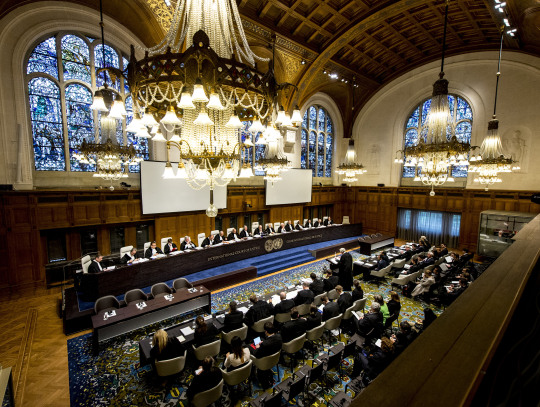
In anticipation of the opening statements of the Qatari government alleging discrimination against the United Arab Emirates, our group of six met Dr. May at the front security gate of the Peace Palace. The case was to begin at 10:00 AM while limited public admission officially began at 9:30 AM. We arrived at the Palace at 9:00 AM and met Dr. May several minutes later. This was followed by the high-strung jockeying of the press corp, diplomatic representatives, and public visitors squeezing into the cramped security processing room. As we made our way into the bustling, glass-walled room, everyone had a passport and official identification card from previous registration. Despite cautious preparation and thorough hindsight, our group was subject the whims of security and constant, often arbitrary, shift in “official policy” of the day. In the end we were denied entrance to the public hearing, being told that there are only 20 seats available for public visitors. We were also denied entrance into the public library until the Court’s public seats were full, then until the diplomatic seats were full, and finally until 10 PM, a time apparently made up on the spot.
The situation was comparable to former Northwestern Law School Dean John H. Whigmore’s condemnation of restrictive, unfair policy as laid out in a series of letters published in the ABA in 1924. In his critical argument against “medieval secrecy,” Whigmore lays out three questions:
1. What is the law about publicity of the Court’s hearings?
2. What is the practice?
3. Who is legally responsible for the practice? (1)
Whigmore found that the Court must be public, the public was not regularly admitted, and the source of this policy was unclear. (1) In the chaotic process of security measures, large crowds, and allowing public access, organization is clearly a challenge. However, public access to the International Court of Justice is profoundly important to worldwide civic participation. Our experience today was a disappointment and cause for reflection into ICJ and Peace Palace policy.
The official ICJ protocol is listed in full online and lists what one would expect for an official public event. However, the last line states “The security staff are authorized to refuse access without giving reasons.” (2) Previous lines also state that entry “does not include a visit . . . on the premises” and that “Members are requested to dress appropriately.” (2)
The ICJ handbook explains the significance of public proceedings and the spread of information, stating that the intent of the PICJ was that “Its proceedings were largely public and provision was made for the publication of the written pleadings.” (3) This further emphasizes the importance of public attendance and an ease of access to visitors.
(1) Wigmore, John H. "SHALL THE WORLD COURT BE OPEN TO THE PUBLIC?" American Bar Association Journal 10, no. 7 (1924): 471-75. http://www.jstor.org/stable/25709032.
(2) "Attending a Hearing/sitting." International Court of Justice. Accessed June 27, 2018. http://www.icj-cij.org/en/attending-a-hearing.
(3) "International Court of Justice (ICJ-CIJ)." The International Court of Justice Handbook. Accessed June 28, 2018. doi:10.4135/9781608717613.n472.
1 note
·
View note
Photo

Henry Dunant (May 8th 1828 - October 30th 1910) was a businessman, best known for founding the International Committee of the Red Cross in 1863, winning the first Nobel Peace Prize in 1901. (1) His book, A Memory of Solferino was written after seeing a lack of proper medical care during the battle of Solferino. (2) His book relayed the horrors he saw to the general public, and inspired the 1864 Geneva Convention. (3) 1: “International Red Cross and Red Crescent Movement is Born,” International Committee of the Red Cross, accessed June 27th 2018 https://www.icrc.org/en/document/international-red-cross-and-red-crescent-movement-born 2: “Henri Dunant,” Encyclopaedia Britannica, accessed June 27th 2018 https://www.britannica.com/biography/Henri-Dunant#ref6509 3: “Geneva Conventions 1864-1977,” Encyclopaedia Britannica, accessed June 27th 2018 https://www.britannica.com/event/Geneva-Conventions
0 notes
Photo
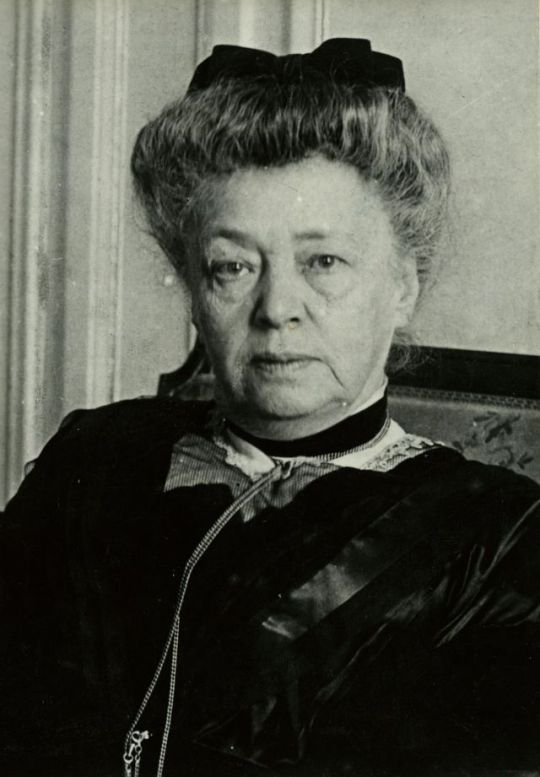
Bertha von Suttner (June 9, 1843-June 21, 1914), author of Die Waffen nieder (1889), was a bold advocate for the abolition of war. (1) After her discovery of groups advocating for peace, von Suttner contributed her own novel to the cause, laying out the horrors of war in Die Waffen nieder, a fiery call for demilitarization in Europe and, ultimately, the entire world.(1) Von Suttner also inspired Red Cross founder Henry Dunant to embrace the vision of a world without war. (2) This bold war-abolitionist message developed into the vision of global cooperation enacted in the 21st century. (3)
(1) "Bertha Von Suttner - Biographical." Nobelprize.org. 2014. Accessed June 27, 2018. https://www.nobelprize.org/nobel_prizes/peace/laureates/1905/suttner-bio.html.
(2) "W. Heudtlass: J. Henry Dunant and the Events Leading to the Award of the First Nobel Peace Prize." International Review of the Red Cross4, no. 36 (June 1964): 138. Accessed June 28, 2018. doi:10.1017/s0020860400013620.
(3) "An Historic Moment with an Inspiring Educational Ceremony." Oudenieuwekerkdelft.nl. Accessed June 27, 2018. https://oudeennieuwekerkdelft.nl/actual/noticias/news-1034.
0 notes
Text
Julia Ward Howe

Julia Ward Howe was an influential seam upon the red thread of history. Born in New York on May 27th 1819 (1), Howe would go on to become a writer, poet, suffragist, abolitionist, and social activist. (2) Howe contributed to the international peace movement through her writing when, in 1870, she authored the book “Appeal to Womanhood throughout the world”. (3) This book was a call for women around the world to take up the call for peace and was an appeal for a women’s peace conference. Howe’s most famous work, “The Battle Hymn of the Republic”, written during the American Civil War (4), would be quoted and referenced in such great American works as John Steinbeck’s novel “The Grapes of Wrath”(5) and Dr. Martin Luther King Jr.’s speech at the conclusion of his famous march from Selma to Montgomery Alabama.(6) Howe died on October 17th, 1910. (7)
1. The Editors of Encyclopaedia Britannica. "Julia Ward Howe; American Writer." Encyclopedia Britannica. May 25, 2018. Accessed June 27, 2018. https://www.britannica.com/biography/Julia-Ward-Howe.
2. "Julia Ward Howe." Accessed June 27, 2018. https://www.poetryfoundation.org/poets/julia-ward-howe.
3. The Editors of Encyclopaedia Britannica. "Julia Ward Howe; American Writer." Encyclopedia Britannica. May 25, 2018. Accessed June 27, 2018. https://www.britannica.com/biography/Julia-Ward-Howe.
4. "Biography." Julia Ward Howe. Accessed June 27, 2018. http://www.juliawardhowe.org/bio.htm.
5. The Editors of Encyclopaedia Britannica. "Julia Ward Howe; American Writer." Encyclopedia Britannica. May 25, 2018. Accessed June 27, 2018. https://www.britannica.com/biography/Julia-Ward-Howe.
6. The Editors of Encyclopaedia Britannica. "Julia Ward Howe; American Writer." Encyclopedia Britannica. May 25, 2018. Accessed June 27, 2018. https://www.britannica.com/biography/Julia-Ward-Howe.
7. "Julia Ward Howe." Accessed June 27, 2018. https://www.poetryfoundation.org/poets/julia-ward-howe.
1 note
·
View note
Text
Andrew Carnegie
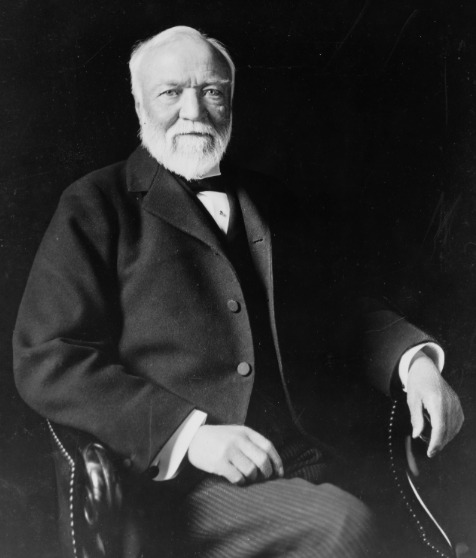
Andrew Carnegie (Born in Scotland November 25, 1835, died in United States August 11, 1919) is known as one of the richest people from his work in the American steel industry, and also a philanthropist. Carnegie was heavily involved in the emergence of international law, with his philanthropic actions emphasizing world peace.(1) Carnegie founded the “Carnegie Endowment for International Peace”, under his beliefs that world peace could be attained through stronger international laws and the involvement of organizations. The Carnegie Endowment for International Peace researches and collects data on policy, and engages in decision making in government, business, and civil society. (2) Carnegie also commissioned the building of the Peace Palace in The Hague, which is home to the International Court of Justice, the Permanent Court of Arbitration, the Hague Academy of International Law, and the Peace Palace Library. (3) His goal in creating the Peace Palace was to eliminate war, inspired by the Hague Convention of 1899.
1. "Andrew Carnegie's Story." Andrew Carnegie's Story. Accessed June 27, 2018. https://www.carnegie.org/interactives/foundersstory/#!/.
2. "About." Carnegie Endowment for International Peace. Accessed June 27, 2018. http://carnegieendowment.org/about/.
3. "Carnegie Foundation." Vredespaleis. Accessed June 27, 2018. https://www.vredespaleis.nl/building/carnegie-foundation/?lang=en.
#andrew carnegie#The Hague#Peace Palace#international law#world peace#hague convention#Permanent Court of Arbitration
0 notes
Photo
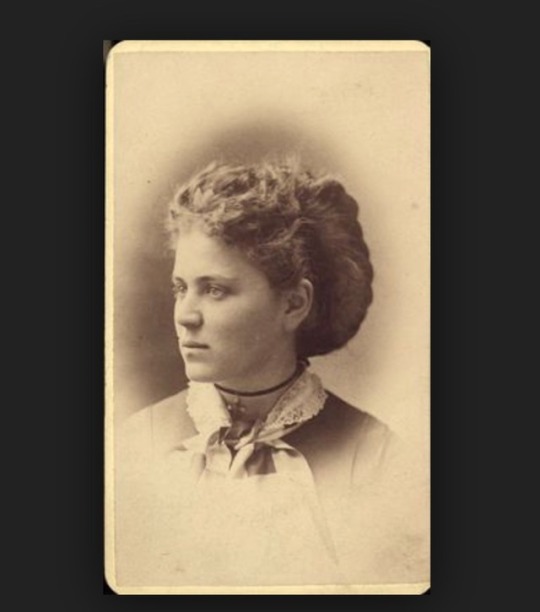
This is the 1931 Nobel Peace Prize winner Jane Addams.(1) She was born on September 6th, 1860 and died from cancer on May 21st, 1935.(1) During her life she started the Women's International League for Peace and Freedom.(2) She was ahead of her time, especially as a woman, for starting such a futuristic organization. She worked for many years to get the great powers of the world to disarm and conclude peace agreements.(2) There are many examples of her work for peace and freedom. An example of her work is during World War I where Addams chaired a women's conference for peace held in the Hague, Netherlands.(2) Another example is that she also tried to get President Woodrow Wilson of the United States to mediate peace between the warring countries.(2) This is very significant since women of her time rarely had a voice; therefore, for her to try to negotiate with the President is astounding. Addams was also critical of the peace treaty that was forced onto Germany in 1919.(2) She was clearly heavily involved in the peace through law movement during her time and has accomplished so much over the course of her life.
(1) Butler, Nicholas Murray. "Jane Addams - Biographical." Nobelprize.org. Accessed June 27, 2018. https://www.nobelprize.org/nobel_prizes/peace/laureates/1931/addams-bio.html.
(2) Butler, Nicholas Murray. "Jane Addams - Facts." Nobelprize.org. Accessed June 27, 2018. https://www.nobelprize.org/nobel_prizes/peace/laureates/1931/addams-facts.html
2 notes
·
View notes
Text
Bertha von Suttner
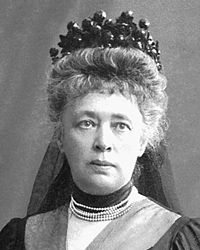
Bertha von Suttner (June 9, 1843 - June 21, 1914) was the first woman to receive the Nobel peace prize in 1905. She was the only woman to attend the opening of the 1899 Hague peace conference.(1) During a period of time where woman were mainly disregarded, this is highly significant. She also founded the Austrian Peace Society in 1891 and acted as president thereafter.(2) She also wrote a wonderful anti-war novel titled 'Die Waffen Nieder' which translates to “Lay Down your Arms”.(2) This book is of a different opinion than the majority of the time so it was controversial, but Bertha was very successful in getting her point across. Her book took the world by storm, and was published in all of the major world languages.
(1) "Bertha Von Suttner - Facts." Nobelprize.org. 2014. Accessed June 27, 2018. https://www.nobelprize.org/nobel_prizes/peace/laureates/1905/suttner-facts.html.
(2) "Bertha Von Suttner - Biographical." Nobelprize.org. 2014. Accessed June 27, 2018. https://www.nobelprize.org/nobel_prizes/peace/laureates/1905/suttner-bio.html.
1 note
·
View note
Text
Cultural Connections: The Importance of Understanding

Pictured above (Left to Right): Chris Bonnen, Nick Boles, Judge Chung Chang-ho, Hannah Sawdon, Bella Barricklow. Picture by Dr. Hope May.
Lessons Learned from the Final Week
In our fourth and final week in The Hague, our class visited the International Court of Justice, held a book launch for the first ever English interpretation of The Barbarization of the Sky by Bertha von Suttner, visited the YI Jun Peace Museum, went to the Korean Embassy in The Hague, attended the ICC’s ruling on South Africa’s interference with the Darfur case, met with Judge Chung Chang-ho, a presiding judge at the ICC, and had a reflection session on our time spent abroad as a class with Peace Palace Library Director, Jeroen Vervliet. During our reflection, each of us discussed what lesson most resonated with us from our time in The Hague.
Having the opportunity to meet with so many passionate individuals reminded me yet again how important it is to make connections with others. Dr. May’s connection with Director Vervliet and the Peace Palace allowed us to hold the book launch in the Historic Reading Room in the Peace Palace Library, her friendship with the owners of the Yi Jun Peace Museum gave us the opportunity to have a guided walkthrough of the museum, the connection made by her former student as a former intern at the Korean Embassy in The Hague established a connection between the Embassy and Central Michigan University Students which allowed us to meet with the Korean Ambassador to The Netherlands and his colleagues, and her familiarity with Judge Chung allowed us to have a personal and very informative meeting with him. Each of the opportunities our class was fortunate enough to have had in our final week in The Hague were due to the connections our professor, Hope May, has made throughout her professional and personal career. With that in perspective, it is clear just how crucial it is to branch out and make connections in one’s professional and personal life in order to create potential opportunities for oneself in the future. For the connections that I have made on this trip, I am incredibly grateful.
The Relevance to International Peace and Justice

Pictured above (Left to Right): Chris Bonnen, Bella Barricklow, Nick Boles, Hannah Sawdon. Picture by Dr. Hope May.
In the budding field of international criminal law, teamwork is essential to accomplishing any end. The International Criminal Court itself, established by the Rome Statute, relies on the cooperation of the 124 State Parties who are signatories to the statute to aide in bringing those charged with violating international criminal law to justice. Without the support and participation of the State Parties, the ICC lacks the means to bring those accused to trial, because they lack a police force of their own. The ICC can only be effective as a court if they can work cohesively with the State Parties and often local governments involved in their cases. Similarly, the State Parties often rely on the ICC to prosecute violations of international criminal law, such as war crimes, if they lack the means and proper judicial system to carry out the trials themselves, or if they are in a hostile environment where it is unsafe to hold the proceedings locally. Because of this co-dependency, it is essential that State Parties to the Rome Statute and the ICC work together in order for them to attain the goal of upholding international criminal law.
This relationship reflects a mutual respect and dependency between many nations and the Court, and depicts how important making connections is in the field of international law. Without one or the other, the ICC would fail to be effective in its goal. Because every country, culture, and person is embedded with a variety of differing values and ideals, those working in international law must be patient, understanding, and cooperative with their fellow colleagues, no matter their background. This same concept is applied in international law itself in the matter of complementarity, which governs the relationship between the iCC and national legal orders. If a State Party is able and willing to investigate and prosecute violations of international law in their own judicial systems, then the ICC will allow them to solve the matter themselves. However, if a state party is either unable or unwilling to take on the case, the ICC takes jurisdiction to aid the State Party in the prosecution without replacing the existing judicial system if it functions properly. This is an example of the partnership between the ICC and the State Parties to the Rome Statute that exists in order to uphold international criminal law.
Reflections Post-Hague

Pictured above: Turnip Rock in Port Austin, MI. Photo by Hannah Sawdon.
My Time Home: Upon arriving home, I had approximately two weeks to fit an Michigan entire summer in before I went back to work. In those two weeks I celebrated a friend’s 21st birthday in Holland, MI, visited friends in East Grand Rapids, kayaked to Turnip Rock in Port Austin, MI, hiked the Sleeping Bear Dunes, explored Traverse City, and ate tons of ice cream. Being home and back to familiar place and routine has been amazing, but after spending a month abroad, I can’t help but start to miss the places and people I became so familiar with during our trip.
The Acclimation Process: Immediately after leaving the airport the day I landed back in the US, I could tell that I was no longer in The Hague. Although I recognized the area and highways, it seemed so strange to be back after becoming acclimated to the overall atmosphere of The Hague, and Europe in general. Even seeing road and street signs in English initially caught me off guard, since it was something that had been so uncommon in The Hague. Once I arrived home, I felt relieved to be back but somehow out of place in my own home. It probably took nearly a week for me to begin to feel comfortable and normal in my own home again, and realizing that I was supposed to be here and not at the Skotel in The Hague. I was surprised to realize that I had to re-adapt to my home environment after becoming so comfortable in The Hague.

A Personal Lesson Learned: Over the month that our class spent abroad, we experienced numerous situations that helped us become more understanding, more patient, and better colleagues to each other as well as those we met through the course of our class. One very valuable personal lesson that I learned was to be more compassionate and empathic with others, both personally as well as professionally. While it is true that personal relationships are not required among colleagues, through the course I learned that attempting to learn another person’s point of view or the position that they’re currently in can create a greater level of understanding between two coworkers, cohorts, or friends, which benefits the relationship and produces better results professionally.
A Conceptual Lesson Learned: Conceptually speaking, I could list hundreds of tidbits of information I jotted down during the class or that I could recite from memory due to their significance. While abroad, Professor May would often ask us if an event had educational substance or if it was more of what she referred to as “a spectacle”. Though there were many instances of spectacle during our travels, the substantive knowledge we learned is invaluable and something one can only understand through experience.
One specific conceptual lesson that I learned in The Hague is the intricacy of the international law court system and the challenges they face in their practice. By meeting with sitting ICC Judge Chung, I learned how difficult it can be to guarantee appropriate time to both the defense and prosecution while also trying to complete cases as efficiently as possible. By learning first-hand how the international court system works, and by attending multiple court sessions held by the ICC, the MICT, and the ICJ, I was able to put into perspective how lengthy and meticulous trials could be. While most of the world is unaware of the ICC or what it does, I am grateful to have first-hand knowledge of the Court, to have met with a presiding judge, and to have an understanding of the process of international law.
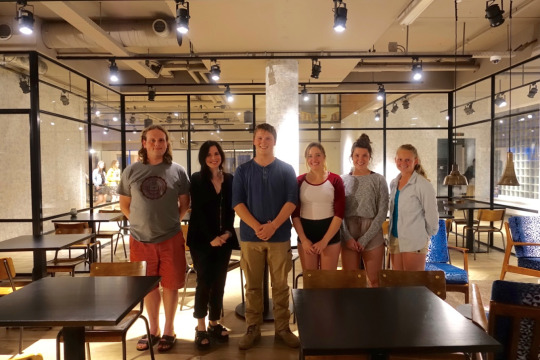
1 note
·
View note
Text
Seeing More
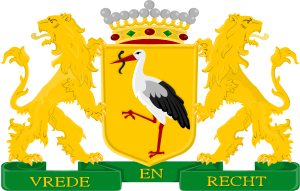
Lessons Learned from The Final Week
Perhaps the most lingering lesson from the final week came at the Hague Institute for Global Justice. The panel we saw addressed international due process and vibrant debate ensued. One professor on the panel, Kevin Jon Heller, argued that the Rome Statute does not establish international standards for due process, so if the International Criminal Court is to defend due process standards it should refer to the relevant domestic standards and where they are not followed it can often be said that proceedings “are being conducted in a manner which, in the circumstances, is inconsistent with an intent to bring the person concerned to justice,” meaning that the International Criminal Court may assume jurisdiction (According to Kevin Jon Heller defying due process standards can be “inconsistent with an intent to bring the person concerned to justice” because a person cannot be brought to justice if a case or important evidence is dismissed on procedural grounds). However, other experts present expressed a belief that international standards for due process are necessary.
It is easy, when looking from a distance, to believe that the experts have everything figured out and are proceeding in sync with one another to advance international justice (or any other field one may explore). The Lesson reinforced at the panel is that advancing our knowledge and our understanding is not only a matter of learning the facts and passing them along; we must also engage in ongoing debates about how best to interpret facts and apply our knowledge.
The relevance to International Peace and Justice
This lesson is relevant to international peace and justice because advancing peace and justice requires grappling with these debates. The most hyperbolic versions of either argument regarding international due process and the International Criminal Court suggest that the opposition would cause a regression our work on international justice to date. A formalist can easily argue that introducing international due process standards without going through the proper amendment process is simply imagining law, and imagining law that is not in the Rome Statute then applying it through the International Criminal Court will deter states from ratifying the Rome Statute and joining the International Criminal Court. In contrast, a realist may believe that due process is essential to justice, so failing to consider international due process in the International Criminal Court (even while it isn’t referred to in the Rome Statute) would be an abrogation of justice. In short, debates are open, and we must engage in them to move forward in international peace and justice (as in any field).
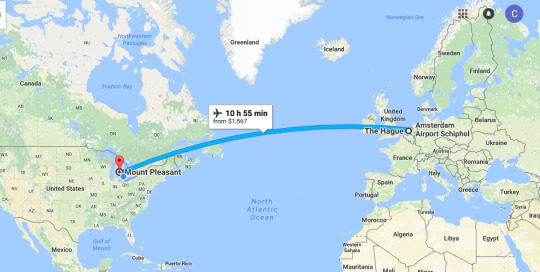
Reflections post-Hague
It’s quite a shift between studying and returning to my job. Jet lag is a beast, and sleep is indispensable, but it was not long to full time work. The sharpest contrast is between working the mind then and working the body now. I see these as complimentary goals, but I lament my now sharply limited time to read.
Personal Lesson
If it seems simple, you probably don’t get it. This is a reconstruction of lesson described above. When you think you understand an issue completely, it’s a good time to look for your blind spots (do you understand how other people see the issue? Especially people who disagree with you?). It is common in politics for people to develop their understanding of an issue only in the context of one ideological framework, but a broader understanding is necessary to develop coalitions and advance policy.
Conceptual Lesson
A conceptual lesson that stands out is the power of the United Nations Security Council to refer cases to the International Criminal Court. This is intriguing to me for two major reasons. Firstly, 3 of 5 permanent members of the Security Council are not state parties to the Rome Statute. This gives huge influence in the court’s jurisdiction to states that do not apparently support the International Criminal Court. Secondly, the Security Council can use this power to require a state to act as though it had signed and ratified the Rome Statute. I wonder if this power will cause more frustration over the inequitable way power is distributed in the Security Council to the point that change becomes necessary.

0 notes
Text
Every End is a Beginning

Lessons Learned from The Final Week
Our final week in The Hague was a strange time. As we flew back from Italy, I had the feeling I was going home. I had to remind myself repeatedly that I did not actually live in the Netherlands, and would be leaving in only a week. As promised, that last week was far shorter than it had any right to be. The time we spent in the International Criminal Court still sticks with me though. In our last week we sat in on both the decision of the South Africa case, as well as part of the Ntaganda case. While interesting in their own right, both cases also caught my attention for how long they had already spent in the courts.
The South Africa case began in 2015, when Omar Al-Bashir visited South Africa. At the time there was (and still is) an outstanding warrant for his arrest in relation to the Darfur Refugee Crisis. South Africa, as a party to the ICC, was obligated to arrest Al-Bashir, and they did not. The case, essentially a matter of whether or not South Africa failed to meet their legal obligations, took two years to make it through the court. The Ntaganda case was also opened in 2015, in relationship to crimes allegedly committed between 2002 and 2003. At the time of our visit, some of these crimes were fifteen years past. While I knew it took time to prepare a case and acquire the accused for trial, I had never realised just how long it could actually take. When I stop to consider that it has taken two thirds of my lifespan to make it to the first round of defense hearings in the Ntaganda case, it makes fifteen years a much less abstract figure. In my final week in The Hague, I learned that the wheels of international justice grind slowly, and we can only hope, inexorably.

The Relevance to International Peace and Justice
An old adage says that justice delayed is justice denied. What sounds so simple on paper is much harder to apply to life. In this case, we’re forced to wrestle with what exactly it means for justice to be “delayed.” In an ideal world, criminals would be caught within days of their crime, sentenced shortly thereafter, and that would be the end of it. They wouldn’t find grounds for repeated appeals, and would emerge from prison rehabilitated to function in society. But, as Donald Rumsfeld notes, “...you go to war with the army you have, not the army you might want or wish to have at a later time.” In this case, the army in question are the various extant legal systems around the globe. The functional ones are backlogged, with accused waiting detained, sometimes for years, for their trial. Compared to the ideal world, this doesn’t seem speedy. But in the world we live in, it seems to be the best we can manage. The same can be said of the Ntaganda case. It may have started 13 years after the first of the crimes were allegedly committed, but it’s the best we can do with what we have. When you consider the logistical issues of arresting a man acting as a leader of a revolutionary army hiding in the bush, it seems reasonable to open a case over a decade after the alleged crimes were committed. In this sense, I’m inclined to agree that the ICC is doing it’s best to be speedy.
But there is another sense of the adage to consider. Justice does not merely concern punishing the guilty, but in providing closure and recompense to the victims. In this sense, modern judicial systems struggle. In my daily life, I often see news stories of people being cleared or convicted of charges related to high profile killings from years ago. There are usually links to old stories summarising the events at the time. When you need a summary of the original act, things are clearly running slowly. In these cases, the families often complain about the slow pace of justice. And this is in purely local crimes, where the accused are not hiding in the bush with a loyal and heavily armed militia. In cases such as Ntaganda’s, where the process of actually detaining him took years, this situation is only worsened. While the ICC does well as an instrument of justice in the sense of punishment, it functions poorly for the speedy redress of victims. This perhaps explains the perception of the victims of those prosecuted by the ICC that it does not care for the victims, but only seeks to impose its standards of justice on the world. In my opinion, it is essential for the ICC to do all it can to improve the speed with which it begins and concludes trials, for the sake of the victims. This would be a significant step forward in terms of legitimising the ICC in the eyes of the victims.

Reflections Post-Hague
Homecoming
In the penultimate segment of The Dream-Quest of Unknown Kadath, Nyarlathotep explains to Randolph Carter that the city he dreams of, “... your gold and marble city of wonder is only the sum of what you have seen and loved in youth... this loveliness, moulded, crystallised, and polished by years of memory and dreaming, is your terraced wonder of elusive sunsets; and to find... [the] steps to the city of broad squares and prismatic fountains, you need only turn back to the thoughts and visions of your wistful boyhood.” I couldn’t shake the resonance I felt with these words as I boarded the plane in Schiphol airport. After three days in Iceland, spent dreaming of home, I finally touched down on US soil. North America, at last. As my train drew closer and closer to the Lansing, I felt like a hobbit who had traversed Middle Earth, and was finally returning to the well worn and deeply missed country of their birth. Prior to the trip, I had never really considered what home meant. But the process of returning left me with a deep appreciation for the value of home. It was much more than just the same house. Shifting back from all the little things I had to adapt to in Europe, different electrical outlets and a lack of ice cubes and all that, to the things I took for granted about life in the states, all reinforced the feeling of home. The process of re-acclimating to the states wasn’t a process at all. I dove back into my old routines, revisiting old haunts and habits that felt long abandoned. I knew I’d only been gone for a month and a half, but somehow it felt like years.
A Personal Lesson
I’ll admit that I’m not the most social of people. Part of the challenge of studying abroad was transplanting myself from my existing social circles into totally new ones. While I’ll admit I didn’t do the best job, the contacts I made in The Hague convinced me of the merits of a little more socialising. Specifically, I’m thinking of the Peace Palace security guard who I befriended during the peace flag raising. I and some of the rest of the group ended up spending time outside of class hanging out with him, as he turned out to be a great guy. The same can be said for the bartender of our favorite hamburger establishment. I feel that I made friends with the two men while I was in The Hague, and I know that if I just bite the bullet and socialise I can make more friendships like that.
And a Conceptual Lesson
During my time in The Hague, I heard about a great deal of interpersonal conflict between people and groups all nominally working for peace. From the conflict between Henry Dunant and Bertha Von Suttner regarding the best approach to peace to struggles within the Dutch Carnegie Foundation I saw people, all of whom were supposed to be working for peace, locked in conflict. Prior to this, I’d never had such a close up view of the daily struggles caused by different approaches to the same cause. At this point in my life, I’m not engaged with any cause to the degree of entering conflicts about the best way to pursue an end goal. But seeing it here gave me, if not a good idea what to expect, at least a rough outline of the ways such conflicts can occur. Not an immediately useful lesson, I have a feeling that as I grow older and debelope into some sot fo professional, I’ll look back and see echos of the conflicts I observed in this class in my day to day work.
0 notes
Text
Learning Vigorously and Learning Peacefully: Connecting the Fragments of our World with Education

Our class at the Yi Jun Peace Museum
Lessons Learned from the Final Week
One of the most important lessons I learned from our time in The Hague came to light during the final week of class. During this week, we spent one full day on Korea in The Hague. During this time, we visited the Yi Jun Peace Museum where we learned about Korea’s attempted involvement in the 1907 Second Hague Peace Conference. We learned that the Korean envoys sent to The Hague were not allowed to be a part of the conference and, therefore, could not ask the international community for help in recovering Korea’s diplomatic sovereignty. The museum also taught us about issues in Korea at the time when Japan was attempting to control Korea using its government.
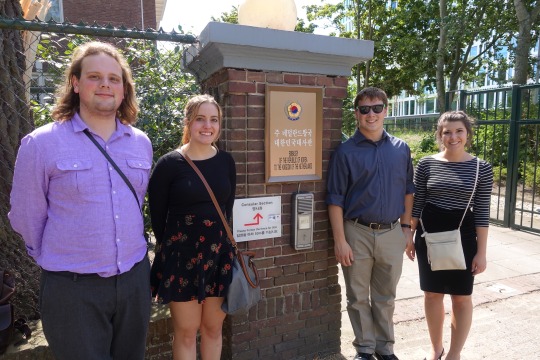
Our class at the Embassy of the Republic of Korea to the Kingdom of the Netherlands in The Hague.
During this day, we also traveled to the Embassy of the Republic of Korea to the Kingdom of the Netherlands in The Hague. Here we learned about the younger generation in Korea and their current involvement in peace movements. We spoke with diplomats at the embassy about how individuals in South Korea are fighting against the human rights atrocities in North Korea. When these diplomats asked us what we knew about Korea, we, the students, did not know any of this. They also asked us about our culture, what younger Americans think of Korea today, especially related to the division between the Koreas, and whether or not the younger generation in America is interested in world events. The experience at the embassy was an exchange of knowledge. Rather than one party lecturing another, we asked each other about peace and justice and all learned from one another.
The day we spent learning about Korea taught me a lesson on education. Our experience at the embassy and the museum proved that there is an important history related to a collective world peace that many people do not know about. The U.S. and Korea seem not to be educated about each other. Koreans seem to be uncertain about what Americans think of their country and their situation, and Americans seem to be unaware of what is going on in Korea, especially related to peace. What is shocking about all of this is the gap in knowledge. Most Americans do not know about what happened in 1907 with Korea, and most do not know about the efforts of individuals there today regarding human rights issues. It is haunting to think of all that could be achieved if the countries were even closer and worked together, but there seems to be a hesitation between the two. This is likely because of a lack of education.
The Relevance to International Peace and Justice

Education is the first stepping stone on the path to creating peace
A large part of international peace and justice lies in education. Many of the miscommunications between countries or individuals are the causes of major injustices or acts of violence in the world. A lack of education about other countries and their cultures and traditions can lead to a separateness between nations that causes fear and even leads to war. Education about cultures is also essential in making sure justice is actually complementary to the traditions and needs of the country that is seeking justice. If Americans knew more about the efforts of individuals in Korea to prosecute North Korea for human rights issues, then we might be more involved in the process of helping bring justice to the victims of these atrocities. However, education in the U.S. fails to mention that this is happening in South Korea. Much of the American education on Korea is about North Korea and is aimed at creating fear. Students hear about their potential use of nuclear weapons against the U.S. and a hatred harbored for Americans. They are taught that injustices occur daily in North Korea, but they are not taught that people in South Korea are trying to take action against it or what Americans can do to help. Furthermore, they only learn about the negative side of Korea’s history that is related to the war and the separation. They are not shown Korea’s desperation to be a part of the Second Hague Peace Convention in 1907 or how strong the bond between America and Korea was even during the Korean war.
May Wright Sewall, an American educator and reformer, said that peace must be taught through positive history. If students only grow up learning about the negative history of a country, such as all of the wars it fought, they will not believe their country to be capable of peace. However, if they learn about the positive steps their country took towards peace, they will see the potential for their nation to continue on that path and understand that there is an alternative to war. This is also the idea of the word “schatzwiederentdeckung,” a term our professor, Hope May, discovered that means recovering a buried treasure, for example, a positive peace history in a nation’s past. This is what the education at museums like the Yi Jun Peace Museum and discussion with diplomats at the embassy can provide for individuals. Experiences like these help to recover, through education, a positive past, and help to uncover the positive present that is not being talked about enough. At the Bertha von Suttner Master Class Don Ferencz talked about the ability of countries to turn people who are diverse and different into the enemy of the citizens and justify treating them unjustly. If the U.S. educates its people as if all of Korea is North Korea, a place and a people to be feared, it enables Americans to enact all sorts of injustices. The U.S. does not usually do this with education, but the possibility is always there. Promoting justice involves reducing fear by using education to create common understanding and acceptance of each other.
This is necessary if countries like Korea and America will ever understand each other and work together to create peace. Both countries need to have a common understanding of each other’s goals and histories. Each country needs to decide what peace and justice means to their citizens and educate them correctly about the other country and its citizens. Education is an exchange. It is conversation between different parties who come together for the purpose of understanding one another better in order to connect and work together. In small ways, education brings us closer together and allows for the creation of a world where countries are not afraid of each other, but interested in each other and willing to work together. This is how lasting peace and justice are formed.
Reflections Post-Hague

Schipol airport
Time Home
For me, coming back from The Hague has been a whirlwind adventure of its own. In just a short time, I visited with many friends and family members who ask me about my time in The Hague. It is difficult to respond to this question, since we did so much while we were there, and I want to explain it all to them. However, I realize that most of the information about what we did, especially the terms and individuals related to international peace and justice, is completely foreign to many people here. For example, when I mention to people that we sat in on the South Africa decision at the International Criminal Court, most of them have no idea what I am talking about. When I mention that we stayed at the castle of Fey von Hassell, many of them smile and nod through the story but never really understand the deeply changing experience that it was for us. It is hard to comprehend how such meaningful and significant moments on the trip can be just words to people here. Even the ones who do understand how lucky we were do not fully understand the emotions we experienced. There really is no way to put into words for others the way in which this experience changed me, and sometimes it is frustrating when people back home want to act like everything is normal when I feel like so much has changed. It is even harder to explain to others the nostalgia for our days in The Hague when returning back to a life without any of our daily adventures and immersions into a new area of the world.
Acclimation Process

Ann Arbor, Michigan (home for me)
I have not had to acclimate too quickly to life in the U.S., since a student from Germany arrived to live with my family just days after I arrived home. I will travel to Germany with her in just a month. In a way, it was convenient that my trip was so close to her arrival, since most of the conversions from European to American standards that she was doing upon arrival were conversions that I had just been doing in reverse for a month. It felt like having a piece of Europe back home in the United States with me. The only thing that was missing was the tram system. It is almost as if we acclimated together. Acclimating while also trying to bridge the gaps for someone from Europe gives me a firsthand view of what I must have seemed like abroad, but it also helps me to be more sensitive to the differences in culture and things that need explanation. Upon returning from the states, some of our traditions suddenly seem more strange than they did before. While I have traveled enough in my life that I am not regularly phased by rapid changes in practices and traditions, each time I leave somewhere, I come back and view my own country in a new light, sometimes with pride for certain practices, other times with a sense of things that could be done better. This trip allowed me to return with a sense of both and to be especially prudent in noticing minute details in differences in culture that change the way people from other cultures experience the world.
Personal Lesson Learned
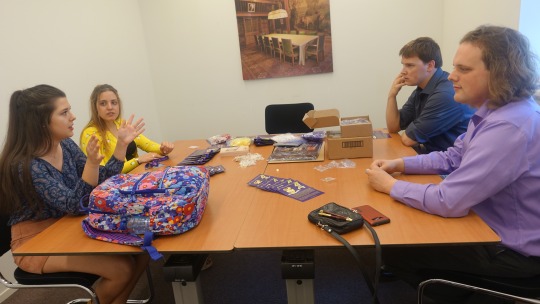
Learning through discussion
Personally, when I think back to The Hague, I am most affected by what I discovered about education. Overall, I learned that the things we learn in our lives are all interconnected, even when we think they never could be. An example is the moment when I was talking to Don Ferencz at the Bertha von Suttner Master Class in Italy. He mentioned a poem by Alfred Noyes called “The Highwayman” that deeply affected both him and his father (Ben Ferencz). For many people, this poem would have been just any other poem that meant nothing at all. However, just a semester before this trip, I studied this poem extensively and even memorized it for a class about children’s literature. This is how I found myself at a castle in Italy reciting a poem with Don Ferencz from my completely unrelated class. This moment formed a connection and a link between us that might not have existed otherwise.
Another example involves language. I knew that my years of Spanish would be completely useless in Italy and the Netherlands. However, I found that my Spanish allowed me to understand the Italian spoken at the Bertha von Suttner Master Class and also connected me to various individuals of Hispanic backgrounds in The Hague. Part of knowledge and learning is making connections. It is as the author E.M. Forster said, “only connect … live in fragments no longer.” Growing and learning more, even if it is not in our area of study and we think it will never apply to what we are doing, does not ever hurt us. Learning more, learning vigorously and hungrily, learning anything and everything we can only helps us to connect the fragments of a relatively broken world to make a better picture. When we learn and connect with others through our knowledge, we can understand each other in new ways, as I found in my small experiences on the trip when I was surprised to use knowledge I never thought I would. When we work to understand each other on emotional levels, we take part in the creation of the world around us and actively bridge the gaps to make it a more connected and peaceful place.
Conceptual Lesson Learned

Cora di Brazzà
I believe that Cora di Brazzà’s ideas about how to create peace have resonated with me the most and created a holistic lesson of the course. At the start of class in Mt. Pleasant, we talked about different methods to promote peace. Henri Dunant had ideas about organizations stepping in during war time, but Cora di Brazzà emphasized education. Cora lived her belief that education could foster peace in her everyday life. In Italy we learned about how she educated the women in her town on how to create and sell lace as well as how to make cookies. She empowered people and taught them how to be a part of society in a peaceful and industrious way. She steered them away from being violent by educating them and empowering them. When people are empowered, they do not turn to violence because they have no need. Education is also necessary to show people how to accept and be kind to others. Cora’s ideas are infused in the experience of this course. It is as if her ideas were a part of the collective subconscious. She lives on through her descendent, Federico Pirzio-Biroli, who endeavors to create peace and harmony in Africa by empowering people and allowing them to be entrepreneurs. He is giving them the means to continue to educate others in their community on spreading peace. He gives them a sense of empowerment through being able to contribute to their community (including the world community). The peace movement that exists in The Hague lives on through the same concept that Cora mentioned. Individuals at organizations wholeheartedly seek to educate others, both citizens of The Hague and those who come to visit, on the idea and history of peace. This can be seen in the Hague Talks events, the countless museums for peace history (including the Peace Palace Visitor’s Center ) and the willingness of individuals, such as judges; lawyers; library directors; or any others, to meet with young students and talk with them about peace. While Henri Dunant’s ideas were valid and make sense, for the common person, Cora’s ideas are simple and attainable.

Learning from Corrado at Brazzà
This class was a trial of Cora’s ideas that proved them to be right. As students, we learned about positive history, which is what made us first start to question the use of violence and the ethical issues of war while still in the classroom at Central Michigan. When we went to The Hague, we immediately entered into the world of the individuals who work there who taught us what peace and justice look like in everyday events. Once we learned about the efforts of different countries and individuals towards making peace, it was impossible not to notice the difference that is being made and impossible not to feel the pull to be a part of it. We even learned from each other and developed more in-depth ideas through conversation about various topics and by debate. It is easy to say that one should work for peace, but if it seems like one is alone in the endeavor, it is easy to give up. If one is educated by others and given examples of how to engage in this process, it becomes much more feasible. It is in this way that Cora’s idea is made real. Education makes peace efforts tangible and shows the ways in which one might start and take part in the effort. We were continually learning through our time at The Hague and Castello di Brazzà. We did something simple, learning and becoming empowered in our knowledge, and it made an impact on us that was, as Cora predicted, not simple or small at all.
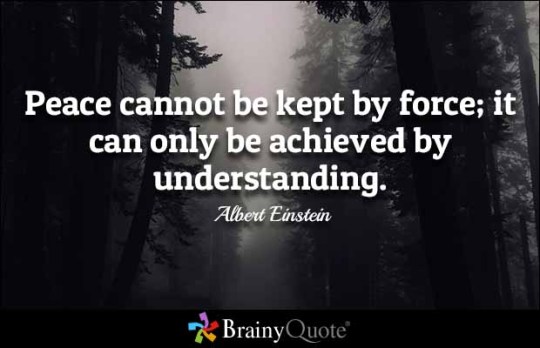
A quote by Albert Einstein that is consistent with Cora’s beliefs about peace and education
The lesson is, for the ordinary person, peace does not have to be a large, lofty, impossible goal. Education is peace and peace is education. Cora believed that the two were inseparable, and I have come to agree with this idea because of the ways in which I have changed since my time in The Hague. One is never done learning and can always learn new ways to be peaceful, such as memorizing the Seven Rules of Harmony or discovering the meaning behind the peace badge pin. One can always become a more peaceful person, and one can also always spread peace in small ways. Education can be as simple as telling someone about the history of peace or being kind to another person and serving as an example. Cora had it right all along and was a living, breathing example of the concept. One can create the world one wants to live in. We raise children to be the way they are and our actions influence the way others, in turn, act towards those around them and towards us. If we want to live in a more peaceful world, we have to teach others what it means to be peaceful, and that means teaching ourselves as well and living what we learn. Cora’s lesson is that we are all students, and the takeaway is that peace is not the end goal, but the entire journey itself.
1 note
·
View note
Text
Tying It All Up: the Red Thread and the Castello di Brazza
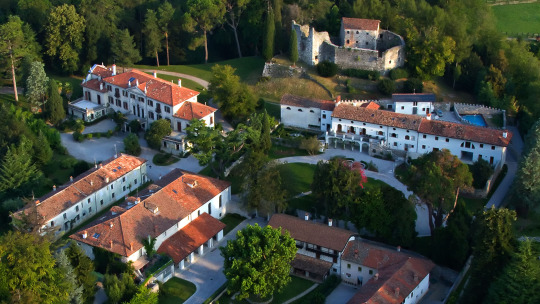
The Castello di Brazza was surreal. An hour away from the nearest village, the estate has a lovely view of the surrounding countryside and the distant alps. The buildings are classically Italian, and the millennia old castle in the back serves as a nice set piece for it all. Meeting the family who owns such an estate was even more surreal. The Pirzo-Birolis are, in essence, aristocrats. Corrado, who owns the estate, is the great grandson of the German Admiral Von Tirpitz. Yes, that Von Tirpitz. His wife Cecil is the heiress of Anheuser-Busch. Their son, Federico, has built a successful investment company in London and is now doing the same in Kenya. In his spare time, he spends a month at the Burning Man festival every year. The life they lead is so vastly different from ours, yet they were still lovely to spend time with.
What I Learned From the Master Class
We went to Brazza to tie together several threads. Bertha Von Sutner, Cora Di Brazza, the seven rules of harmony, the UN and atrocity prevention, all tied with a red thread. We also spoke about Corrado’s mother’s book, “A Mother’s War.” Speaking about that book will stay with me for a long, long time. Each of the four students in the study abroad class selected a core theme in the work, and during the Master Class we each discussed our selected element. Analyzing a work with the child of the author present was rather stressful, but entirely worth it. Watching the Pirzio-Birolis react to people with no tie to the family speak in glowing terms about Fey Von Hassel, Corrado’s mother, was magical. Here were four kids from Michigan speaking in Italy about a German woman struggling to find her children, to one of the missing children. To see us giving such a careful and thorough treatment to his mother’s book moved Corrado deeply. It moved me as well. I think it also really highlighted the significance of what Professor May refers to as “memory work."
Memory work is the English translation of a German word, vergangenheitsvewaltigung. It refers to dealing with one’s past, the darkness and painful elements that we’d rather forget. Yet until now, there has be no word for the reverse, for identifying and celebrating the rediscovery of positive history. Professor May is changing that, working with a translator to coin the word schatzwiederentdeckung. Rather than dealing with negative history, as vergangenheitsvewaltigung does, schatzwiederentdeckung deals with (and translates as) "finding a buried treasure” and recovering stories of positive history. I think that is what I take most away from our Italian expedition. I was directed where to look to find the treasure in “A Mother’s War.” But presenting about that book to Corrado gave him a moment of the same discovery. He learned that his family was not the only one to know the story of Fey Von Hassel, and that others from around the world found it as powerful as he did.
The Master Class, for Corrado and I both, was an example of schatzwiederentdeckung. Corrado learned that others shared his passion for his mother’s story. I learned a great deal about the philanthropic activities of another ancestor of Corrado’s, Cora Di Brazza. Her work establishing lace schools and biscuit (cookie) factories to provide dignified work for Italian women is one more example of positive history that was largely forgotten. It is also an example of the red thread which Bertha Von Suttner writes about, tying together all the efforts of the peace movement, old an new.
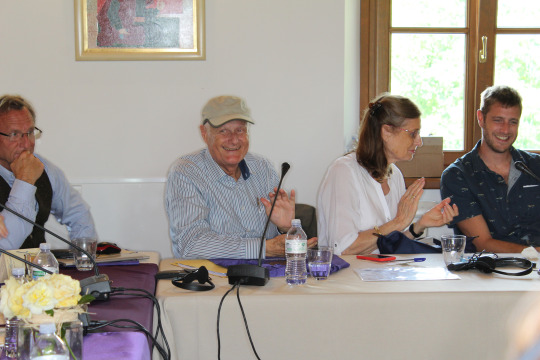
The Relevance to International Peace and Justice
As Bella noted in her presentation during the Master Class, it’s so easy to get bogged down in all the things wrong with the world today and not do anything. There are many antidotes to such a poison, but for me the rediscovery of lost stories and examples of positive history is particularly effective. This is schatzwiederentdeckung. It is also an example of the red thread Bertha Von Suttner writes about. Rediscovering the stories of the peace movement at the turn of the 20th century is not just a historical pastime. It provides inspiration and support to the living, breathing people who are struggling a century later for the same goal. To know one’s history is to know who one is. So how can the peace movement know who they are without rediscovering these stories?
The red thread is also important to guide further efforts for peace. The Nuremberg Tribunal tried German leadership for “crimes against peace” based on the Kellog-Briand pact which outlawed aggressive war as a tool of national policy. Had the Nuremberg Tribunal lost that piece of history, their efforts would have taken a different shape. The same is true with ICTY, ICTR, and MICT decisions shaping future interpretations and implementations of international law. Where the knowledge is lost, the path ahead becomes murkier. When the red thread ties our efforts together, the path forward becomes more clear.
0 notes